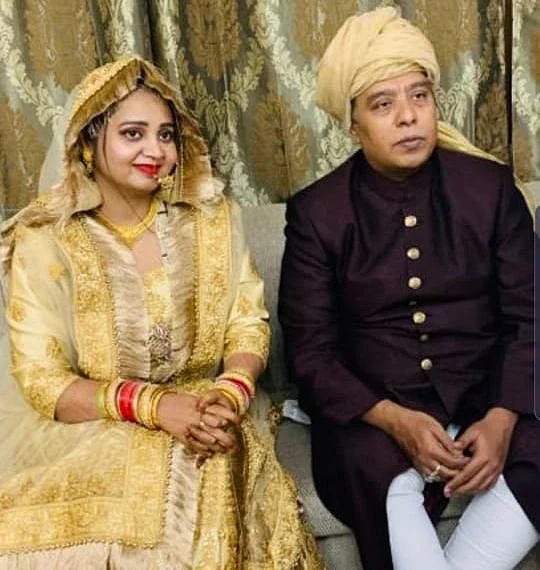Ustad Waifuddin Dagar gets married to Zainab
With Ustad Wasifuddin Dagar’s marriage to Zainab, which took place this spring, just days before the lockdown, the legacy of their unique style of Dhrupad rendering is sure to continue

The very first time I had attended a Dhrupad concert was in the mid - 80s, at the residence of the then envoy of Qatar to India, Dr Hassan Al Nimah. The setting was perfect ---under a huge white shamiana erected on the sprawling lawns of the ambassador’s residence, the two Dagar brothers, Ustad N Zahiruddin Dagar and Ustad N Faiyazuddin, rendered Dhrupad.
I hadn’t ever before heard such soul touching classical singing …there was something or everything divine about their rendering; taking one ever so gently towards another level altogether…I kept in touch with the Dagars and their families and was left so impressed with their modesty and simplicity that decided to delve further into their classical music, their journeys, their everyday living, their views and viewpoints ….so much that I wrote this volume on them– Dagars & Dhrupad ( Niyogi Books).
The Dhrupad, sung by Dagars is one of the oldest surviving classical traditions, dating from the 15th century when a Dagar was a court musician for the Mughal Emperor Akbar. And it is continuing to this date. Today, with Ustad Wasifuddin Dagar, it’s the 20th generation of the Dagars rendering this particular form of Dhrupad.
And now with Wasifuddin’s marriage to Zainab, which took place this spring, just days before the lockdown, the legacy is sure to continue … upcoming would be the 21st generation of the Dagars! Inshallah!
In fact, the history of this classical singing, carries such diverse and interesting turns to it, that an entire feature film can be made revolving around it and, of course, around the Dagar clan that’s kept it going … And if I were to focus on its recent history, then its best to quote Wasifuddin– “ In 1857 when the last Mughal Emperor Bahadur Shah Zafar was arrested and sent to Rangoon, almost all the courtiers left Delhi to settle in neighbouring states like Rampur, Alwar, Jaipur. Ustad Behram Khan Dagar who was already 104 years old at that time, was one of them.”
He travelled to Rajputana along with his entire family and at least 20 disciples. And the first state that he reached was Alwar but the Maharaja of Alwar felt his state was too small for such a great musician. So the Ustad sahib proceeded further towards Jaipur , which was ruled by Maharaja Sawai Ram Singh. He recognized the Ustad’s genius and requested him to settle down in Jaipur. He also became his disciple and became so devoted to his guru that offered him a jagir of seven villages.
And though Ustad sahib was touched by the gesture but told the young Mahajara, ‘what will I do with this jagir ! My children will fight over this property after my death and I would rather they devoted their lives to music than to vain battles in court over property.’ The Maharaja was deeply impressed by such wisdom coupled with far sightedness and immediately fixed a monthly salary of Rs 60 for the Ustad Sahib and he began teaching Dhrupad. His disciples grew in number and spread out. He is said to have taught Ali Baksh, Fateh Ali of Patiala , Ghokli Bai , her son Abdullah , Edu and Kabira and several others.
Together with teaching he continued with his scholarly work -- his work on the Shastras and Granthas is said to be unique. He devoted all his time and energy to analysing in depth all the musical technicalities contained in theoretical form in these treatises and then he explained to his students to apply these techniques along the practical strain. He has a unique place in the history of Indian classical music for having taught so many musicians who went on to become great in their respective fields. The last 20 years of his life may be considered his golden years. Because of the Maharaja ‘s patronage Ustad Sahib could spend all his time to music and teaching his disciples. In fact, he had become so deeply attached to the Maharaja that when he heard the news of the Maharaja’s death, he is said to have uttered only this one sentence before himself collapsing and dying –‘ Alas, my real admirer is gone !’ ”
The Partition phase did leave scars on artists and classical geniuses. But the Dagars took on this challenge and saw to it that Dhrupad rendering not only survives but goes on to be known far and wide, nationally and internationally, as the purest traditional form of classical rendering.
Today, Wasifuddin Dagar, the 20th generation of the Dagars, who is also the President of the Dagar Society of India, is carrying on the family tradition of Dhrupad rendering, holding concerts here and in the international circuit.
Follow us on: Facebook, Twitter, Google News, Instagram
Join our official telegram channel (@nationalherald) and stay updated with the latest headlines
